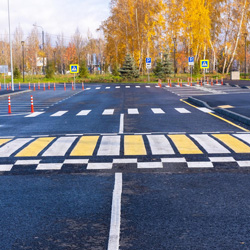In today’s fast-paced world, controlling the speed of vehicles in sensitive areas such as school zones, hospital vicinities, and parking lots has become a critical concern. The safety of pedestrians and drivers is paramount, and one effective solution that has been widely adopted is the installation of speed bumps. These seemingly simple road features play a significant role in traffic management and safety enhancement. This article delves into the benefits, installation, and effectiveness of speed bumps, focusing on their use in community settings.
The Need for Speed Control
Speed control is essential in areas where there is a high density of pedestrian traffic or where vulnerable populations, such as children and the elderly, are present. In school zones, hospitals, and parking lots, the risk of accidents increases significantly if vehicles travel at high speeds. Speed bumps are designed to force drivers to slow down, thereby reducing the likelihood of accidents and enhancing safety for everyone.What Are Speed Bumps?
Speed bumps are raised sections of pavement placed across roads to slow down traffic. They are typically 3 to 4 inches high and can vary in width. Speed bumps are made from various materials, including asphalt, concrete, and recycled rubber. The latter is particularly popular due to its durability and environmental benefits.Benefits of Recycled Rubber Speed Bumps
- Durability: Recycled rubber speed bumps are highly durable and resistant to wear and tear. They can withstand harsh weather conditions and the constant pressure of vehicles passing over them.
- Environmental Sustainability: Using recycled rubber for speed bumps helps reduce waste and promotes recycling. This eco-friendly option aligns with sustainable practices and environmental conservation.
- Cost-Effectiveness: Recycled rubber speed bumps are cost-effective in the long run due to their durability and low maintenance requirements. They do not crack or break easily, unlike their asphalt or concrete counterparts.
- Easy Installation: These speed bumps are easy to install and can be placed on various surfaces, including asphalt and concrete. They come with pre-drilled holes and accompanying hardware, making the installation process straightforward.
The Importance of Speed Bumps in Community Settings
Speed bumps are crucial in various community settings for several reasons:- School Zones: Children are unpredictable and may suddenly dart into the street. Speed bumps ensure that vehicles slow down near schools, reducing the risk of accidents.
- Hospitals: In hospital areas, where patients and visitors are frequently crossing roads, speed bumps help ensure that drivers reduce their speed, thereby protecting vulnerable individuals.
- Parking Lots: In parking lots, speed bumps control vehicle speed, preventing accidents and ensuring the safety of pedestrians moving to and from their vehicles.
- Residential Areas: In neighborhoods, speed bumps help maintain safe driving speeds, protecting children playing outside and pedestrians walking in the area.
Effectiveness of Speed Bumps
Speed bumps are effective tools for reducing vehicle speeds and enhancing safety. Several studies and real-world applications have demonstrated their benefits:- Reduced Speed: Speed bumps force drivers to slow down to avoid discomfort or damage to their vehicles. This reduction in speed is critical in areas with high pedestrian traffic.
- Decreased Accident Rates: By slowing down vehicles, speed bumps significantly reduce the likelihood of accidents. This is particularly important in school zones and residential areas.
- Increased Awareness: The presence of speed bumps increases driver awareness and caution. Drivers become more vigilant and attentive to their surroundings, further enhancing safety.
- Community Satisfaction: Residents in areas with speed bumps often report higher satisfaction due to the perceived increase in safety. This is especially true in neighborhoods where speeding has been a persistent problem.
Addressing Concerns and Challenges
While speed bumps offer numerous benefits, there are also concerns and challenges associated with their use:- Emergency Vehicle Delays: One of the primary concerns is the potential delay of emergency vehicles. To address this, it is essential to design speed bumps that allow for a smoother passage of larger vehicles or consider alternative traffic calming measures in critical areas.
- Noise and Vibration: Speed bumps can create noise and vibration, which may be a nuisance to nearby residents. Proper placement and design can help mitigate these effects.
- Driver Compliance: Some drivers may try to avoid speed bumps by swerving or taking alternative routes. Ensuring that speed bumps are placed effectively and consistently can help reduce such behavior.
- Cost: The initial installation cost can be a concern for some communities. However, the long-term benefits and reduced maintenance costs of recycled rubber speed bumps often outweigh the initial expenditure.

